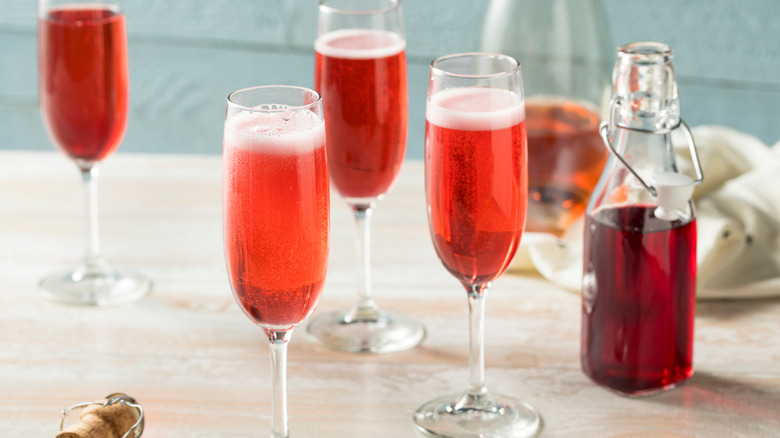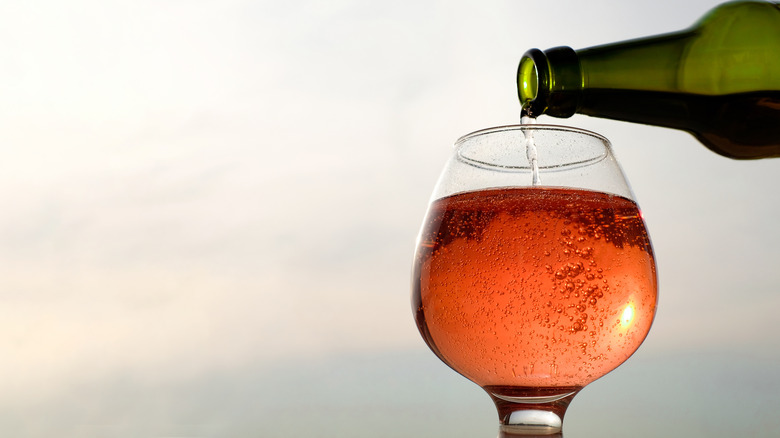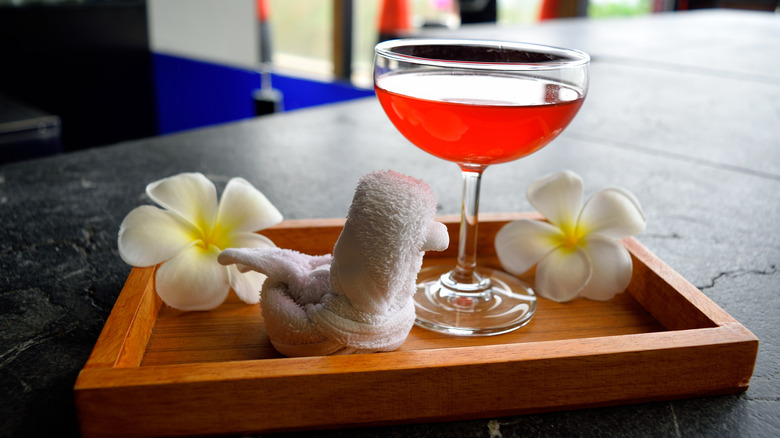How A Simple Sparkling Wine Drink Got The Name 'Cold Duck'
Cold duck is an elevated two-parter (not dissimilar to a highball) made from a combination of sparkling burgundy wine and champagne. (Kir Royale fans, rise up.) Per the lore, its perhaps confusing name comes from a coarse translation of the German "kaltes ende" (cold end), which over time became enduringly mispronounced as "kalte ente" (cold duck).
It all started back in the 18th century with Saxon prince Clemens Wenceslaus Von Sachsen. The prince was either super thrift-minded or a proto-bon vivant because the story goes that he had a habit of combining the dregs of all his half-finished bottles at the end of the evenings. Call it a haphazard "winemaking process," or call it fancy jungle juice. Either way, it's stuck around.
This isn't cold duck's only proffered origin story. Other historians substantiate that the fancy Frankenstein-ed drink started as a common industry practice among waiters, who cleared the dregs of affluent patrons' near-empty bottles of burgundy and champagne and swilled away at shift's end. Another story suggests that cold duck started in German glass punch bowls decorated with spiraling lemon peels, which were thought to resemble the head and body of a duck.
Fast forward to 1937, and a German immigrant called Harold Borgman immigrated to Detroit and opened a now-legendary bar, the Pontchartrain Wine Cellars. As a nod to his roots (or perhaps as a fan of the drink himself), Borgman's sold his own cold duck, a three-parter of Mosel wine, Rhine wine, and champagne.
A formula that works, even if it's fallen out of popularity
Cold duck is all about the understated yet effective interplay of the two sparkling wines. Champagne is made exclusively from pinot noir, chardonnay, and pinot meunier grapes. Still, within these parameters exists a good deal of variety, and modern fans can customize their cold duck by opting for a sweet champagne like Korbel Cuvée or a brut like André Extra Dry.
Darker burgundy wines are made primarily with chardonnay and pinot noir grapes. Burgundy's characteristic rich, dark-fruit-centric-tasting notes are sweet but complex, often leaning tart or semi-dry. Blackberry, cherry, plum, black pepper, baking spice, smoky char, and mineral-forward mouthfeel are common and naturally complement champagne's light effervescent texture and citrus, almond, and apple tasting notes. The combination makes for a medium-dry, light-bodied sparkling wine with a hint of acidity and luscious magenta hue. It goes down fizzy, fruity, and (perhaps dangerously) smooth. For such a sweet sip, the cold duck can bite back after the third or fourth glass.
Cold duck is often served as an aperitif, and like basically all sparkling wines, served chilled. It pairs well with fruit tarts, dark chocolate desserts, brunch dishes, or dark meats. Other variations of the German-American wine punch have cropped up over the years. One popular version of cold duck is a sparkling, herbaceous wine punch made with sweet Riesling, Mosel, sparkling wine, simple syrup, and a variety of fresh aromatics from lemon balm to cilantro.
Keep on duckin'
Thanks to Borgman's influence, cold duck quickly became a favorite among the German-American community in Detroit by the 1940s, and by the 1950s, winemakers nationwide were bottling sparkling wine mixes and calling them "Cold Duck." Alas, it was not to last. By the 1970s, cold duck had largely become a relic of the past in America. Nowadays, André Cellars seems to be the only major purveyor of bottled cold duck on the modern U.S. market.
André' Cold Duck is a California sweet red with top notes of blackberry and cherry, made with French Colombard and Concord grapes. Still, cold duck's final frontier has endured with an element of self-acknowledged kitsch. As the André website puts it, cold duck is "Perfect on its own or in mixers for tailgates and ugly sweater parties," and as the Drizly website description puts it, "Andre brings the bubbles. You bring the bling," for less than $10 per bottle.
Notably, cold duck sales regularly increase by nearly 300% during December, suggesting that enduring fans of the nostalgic drink might consider it as a holiday tradition — which makes sense considering the link between Prince Wenceslaus and the old Christmas carol about "Good King Wenceslas." Luckily, it's simple for fans new and old to whip up a punch bowl of the stuff for their next dinner party, girls' night in, or holiday soiree.


